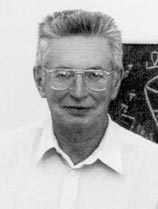

Evgeny E. Nikitin

Born May 9, 1933 in Saratov, Russia.
Professor of Chemical Physics, Technion, Israel Institute of Technology, and Institute of Chemical Physics, Russian Academy of Sciences, Moscow, Russia.
Email:nikitin@techunix.technion.ac.il
WWW: external link
Member of Deutsche Academie der Naturforscher Leopoldina, since 1977; Member of European Academy of Arts, Sciences and Humanities, since 1983; Member of the International Academy of Quantum Molecular Sciences, since 1987.
Author of:
More than 250 scientific papers, and 17 books, of which the following were published in the West:
"Theory of thermally induced gas phase reactions," (Indiana University Press, 1966);
"Theory of elementary atomic and molecular processes in gases," (Clarendon Press, 1974);
"Gas-phase reactions, Kinetics and Mechanisms," (Springer, 1981), with V.N. Kondratiev;
"Theory of slow atomic collisions," (Springer, 1984), with S. Ya. Umanskii;
"Theorie chemischer elementarprozesse," (Akademie-Verlag, 1985), with L. Zlicke.
Important Contributions:
- Development of the theory of nonadiabatic transitions: Generalisation of the Landau–Zener model for low energies (including nonadiabatic tunneling). Development of the most general semiclassical (exponential) model of two-state nonadiabatic coupling. Formulation and first application (in 1967) of the surface hopping approach to description of electronically nonadiabatic processes in molecular collisions.
- Quasimolecular description of slow atomic collions: Quasiclassical theory of inelastic scattering angles, near resonance electronic energy transfer, collisional intramultiplet mixing, semiclassical description of polarization phenomena.
- Mechanism of charge transfer in atomic and molecular collisions: Asymptotic method of calculation of exchange interaction, charge transfer into different fine-structure components of ions and atoms, vibrational relaxation and chemical reaction mediated by the charge transfer.
- Development of reduced-dimensionality models in the atom-molecule collision theory: Development of the optimal trajectory approach in the theory of VTRE processes: practical realisation of the path integral technique for quasiclassical condition. Application to VRT energy exchange and photodissociation. Effect of electronic nonadiabaticity in VRT processes.
- Extensions of statistical theories of chemical reactions: Calculation of the rate constants within statistical models for loose activated complexes with account taken for conservation of the total angular momentum, incorporation of nonadiabatic effects into adiabatic channel model of reactions.
- Nonequilibrium kinetics of vibrational relaxation and thermally-induced dissociations of molecules: Anharmonic effects in vibrational relaxation of oscillators in a heat bath, depletion of level populations close to the dissociation limit, weak collision mechanism of thermal activation of molecules.